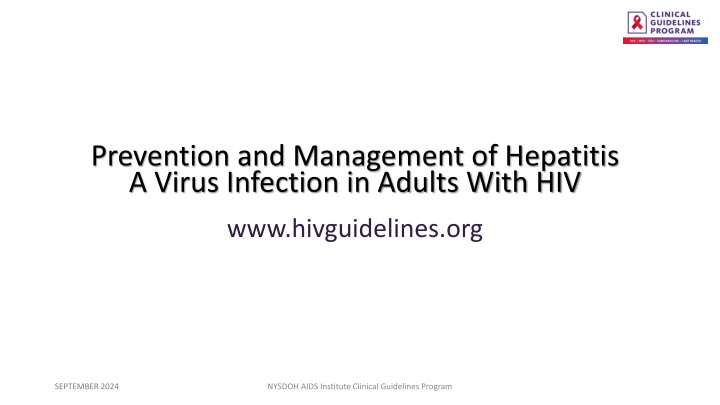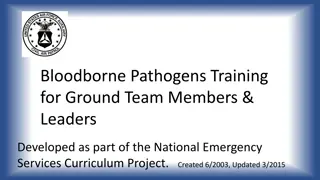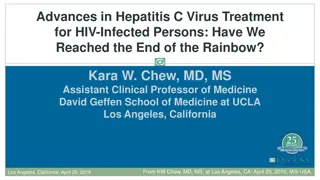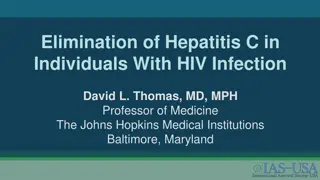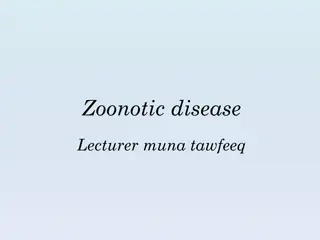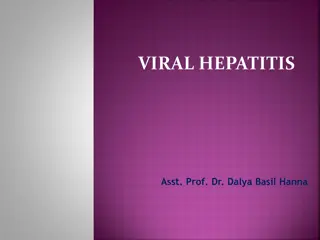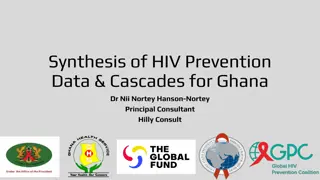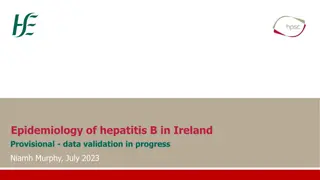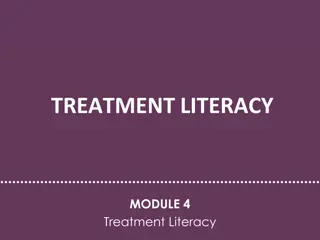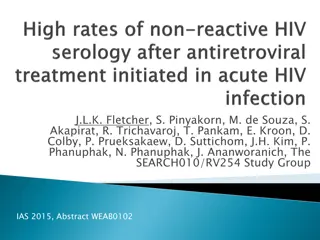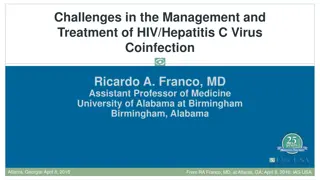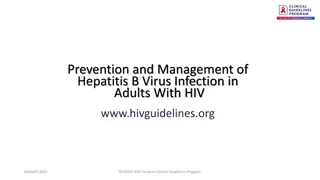Prevention and Management of Hepatitis A Virus Infection in Adults With HIV
This guideline provides evidence-based recommendations on screening, vaccinating against HAV, and managing HIV/HAV coinfection in adults with HIV. It includes information on pre-exposure vaccination, post-exposure prophylaxis, and ART management for HIV/HAV coinfection.
Download Presentation

Please find below an Image/Link to download the presentation.
The content on the website is provided AS IS for your information and personal use only. It may not be sold, licensed, or shared on other websites without obtaining consent from the author.If you encounter any issues during the download, it is possible that the publisher has removed the file from their server.
You are allowed to download the files provided on this website for personal or commercial use, subject to the condition that they are used lawfully. All files are the property of their respective owners.
The content on the website is provided AS IS for your information and personal use only. It may not be sold, licensed, or shared on other websites without obtaining consent from the author.
E N D
Presentation Transcript
Prevention and Management of Hepatitis A Virus Infection in Adults With HIV www.hivguidelines.org SEPTEMBER 2024 NYSDOH AIDS Institute Clinical Guidelines Program
Purpose of This Guideline Purpose of This Guideline Provide evidence-based recommendations on screening for and vaccinating against HAV in adults with HIV. Provide evidence-based recommendations for post-exposure prophylaxis in adults with HIV who experience an HAV exposure. Advise clinicians on the clinical management of patients with HIV/HAV. SEPTEMBER 2024 NYSDOH AIDS Institute Clinical Guidelines Program www.hivguidelines.org
Recommendations: Pre Recommendations: Pre- -Exposure Vaccination Exposure Vaccination Clinicians should obtain an HAV IgG antibody measurement for all individuals with HIV and should administer the HAV vaccine to those who are HAV antibody-negative, regardless of CD4 count. Clinicians should administer the 2-dose anti-HAV vaccine series, with the initial dose followed 6 to 12 months later to ensure maximal antibody response. (A1) Clinicians should obtain a post-vaccination HAV IgG antibody measurement at least 1 month after final dose in patients who are at increased risk of HAV-related morbidity and mortality. (B3) SEPTEMBER 2024 NYSDOH AIDS Institute Clinical Guidelines Program www.hivguidelines.org
Recommendations: Recommendations: Post Post- -Exposure Immune Globulin Exposure Immune Globulin Clinicians should administer a single dose of immune serum globulin (as a 0.1 mL/kg intramuscular injection) as HAV post-exposure prophylaxis to susceptible patients with HIV within 2 weeks of an exposure to close personal contacts with serologically confirmed HAV infection (i.e., through a blood test), including: Household and sexual contacts (A2) Individuals who have shared illicit drugs with someone with HAV (A2) In patients for whom HAV vaccination is also indicated, clinicians should administer the HAV vaccine concurrently with immune serum globulin to protect against future infection. (A3) SEPTEMBER 2024 NYSDOH AIDS Institute Clinical Guidelines Program www.hivguidelines.org
Recommendation: Recommendation: Management of HAV/HIV Coinfection Management of HAV/HIV Coinfection Whenever possible, ART should not be interrupted in patients with HIV/HAV coinfection; when interruption of ART is indicated for management of severe or fulminant liver disease, clinicians should consult with a care provider experienced in the treatment of hepatitis and HIV. (A3) SEPTEMBER 2024 NYSDOH AIDS Institute Clinical Guidelines Program www.hivguidelines.org
New York State Law: Reporting HAV Infection New York State Law: Reporting HAV Infection Clinicians must report all suspected or confirmed HAV infections to the local health department of the area where the individual resides according to NYSDOH Communicable Disease Reporting Requirements. Infections that occur among food handlers or in other settings that pose a high risk of transmission are immediately reportable by telephone to the local health department. SEPTEMBER 2024 NYSDOH AIDS Institute Clinical Guidelines Program www.hivguidelines.org
Need Help? Need Help? NYSDOH AIDS Institute Clinical Guidelines Program www.hivguidelines.org
Access the Guideline Access the Guideline www.hivguidelines.org > Prevention and Management of Hepatitis A Virus Infection in Adults With HIV Also available: Printable PDF NYSDOH AIDS Institute Clinical Guidelines Program www.hivguidelines.org
